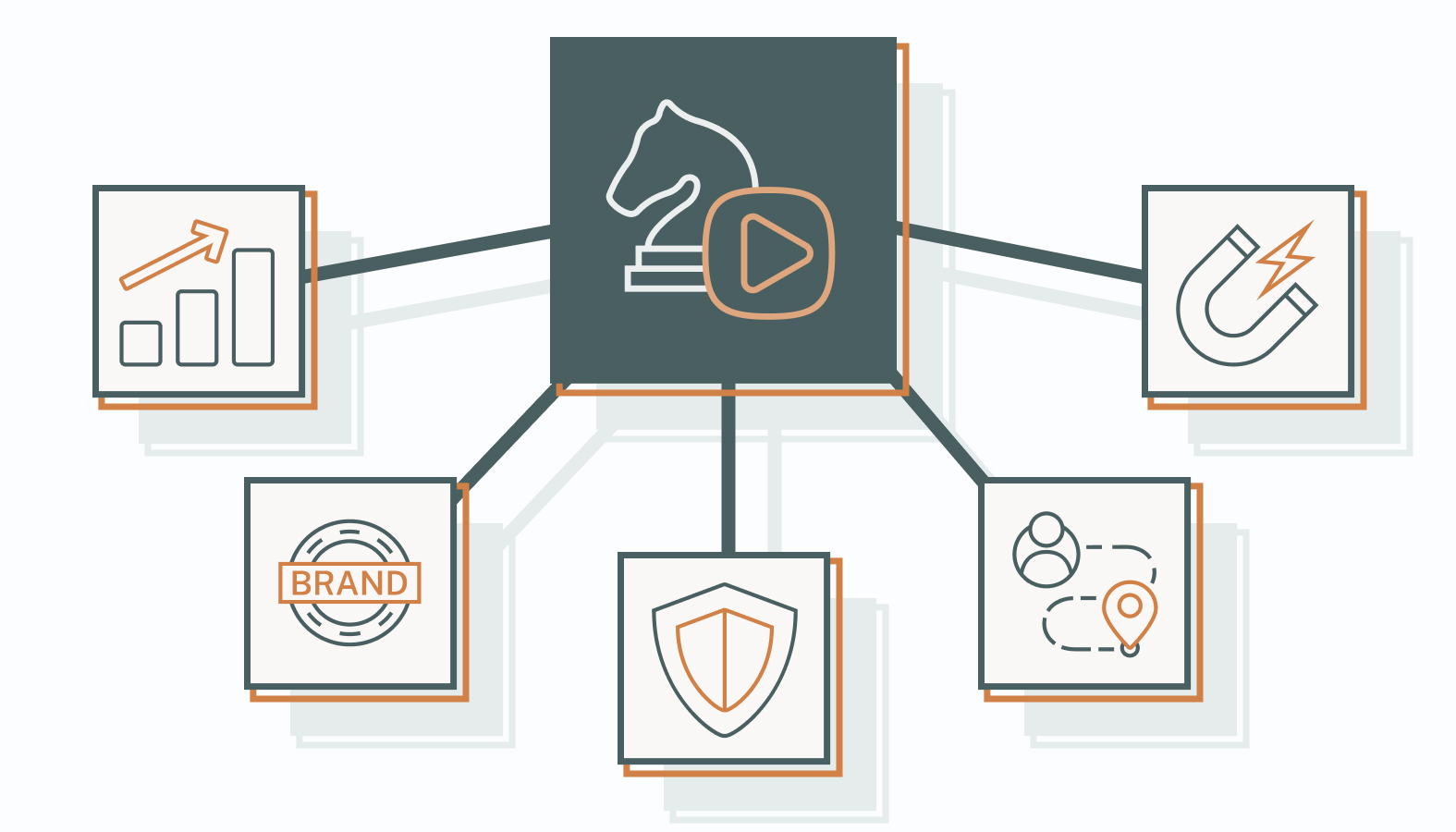As digital trends evolve, businesses need effective methods to not only grab attention but also build lasting relationships for long-term growth. In B2B marketing, a well-crafted content strategy is your secret weapon for turning casual clicks into committed conversions.
This article outlines the essential components of a B2B content strategy and highlights its importance for businesses that want a competitive edge and sustainable growth. It covers how to set strategic goals, understand your audience, and use advanced tactics like predictive analytics and account-based marketing.
Dive in to explore insights that will elevate your content strategy and drive impactful results.
Defining B2B Content Strategy
A B2B content strategy is a comprehensive plan to drive business growth by creating, distributing, and managing content that resonates with business audiences. It aims to engage, educate, and influence businesses with valuable content like blogs, whitepapers, case studies, and webinars. The goal is to attract quality leads, build brand authority, and ultimately, turn prospects into loyal customers.
Compared to B2C strategies, which often focus on emotional appeal and consumer trends, B2B content strategy relies heavily on logic and facts. While B2C might prioritize quick engagement and impulse buys, B2B usually involves longer decision-making and builds relationships through trust and expertise.
Both strategies aim to convert audiences, but B2B strategies often require more in-depth content and a focus on highlighting value propositions and ROI for the client. Essentially, it’s about communicating business benefits, not just brand appeal.
Why a B2B Content Strategy Is Crucial for Business Leaders
Having a strong B2B content strategy is essential for business leaders aiming to drive growth and build lasting relationships. It helps position your brand as an industry leader while strengthening trust and credibility.
Here’s why a good content plan is indispensable:
Drives Business Growth
A targeted content strategy is key to generating leads and turning them into sales. By addressing specific audience needs with valuable content, businesses can attract qualified leads who are more likely to convert.
For example, Salesforce uses eBooks and webinars to address industry challenges. This approach has been pivotal in expanding their market reach and boosting business growth. Such content educates and nurtures leads through the sales funnel, resulting in higher revenue.
Enhances Brand Authority
Becoming a thought leader in your industry helps establish brand authority, and content that showcases your expertise positions your brand as an industry leader. These include insightful articles, detailed research reports, and expert interviews.
For instance, HubSpot publishes comprehensive guides and reports that provide immense value to their audience. These efforts not only build authority but also keep the brand top-of-mind for decision-makers.
Builds Trust and Credibility
Transparent and informative content builds trust in B2B relationships. Customer testimonials and case studies are powerful tools in this respect. They offer real-world validation of your products or services.
Brands like Zendesk use detailed case studies to show their positive impact on clients, which boost their credibility.
Supports the Buyer’s Journey
Content should be aligned with each stage of the buyer’s journey: awareness, consideration, and decision.
During the awareness stage, educational blog posts and infographics can introduce prospects to broader industry topics. As they move into consideration, case studies and comparison guides help evaluate options. Finally, the decision stage benefits from detailed demos and free trials that facilitate informed purchasing decisions.
IBM, with its various content types, effectively guides prospects through this journey.
Drives Engagement and Interaction
Interactive content is a brilliant way to deepen connections with your audience. Techniques such as interactive polls, engaging webinars, and live Q&A sessions encourage audience participation and gather valuable insights.
Adobe, for instance, hosts live events and webinars that not only educate but also establish community, boosting loyalty and brand advocacy among their users.
Essential Elements of a B2B Content Strategy
A well-structured B2B content strategy provides a foundation for creating and distributing content that not only aligns with your business goals but also positions your brand effectively in the market.
Let’s explore the elements that make up an effective strategy.
Defining Strategic Content Objectives
Aligning content objectives with overarching business goals ensures every piece of content serves a purpose. This alignment involves setting measurable outcomes to guide content creation and performance evaluation.
Objectives may include improving lead quality by targeting specific industry sectors, increasing brand awareness through thought leadership content, or enhancing customer engagement by building community interaction. By establishing clear objectives, businesses can track progress and adjust their strategies based on data.
Analyzing Your Target Audience
Understanding your audience is essential to creating engaging content. Developing detailed buyer personas is a crucial step in this process. These personas are based on your audience’s demographics, challenges, and needs.
Techniques for gathering these insights include conducting surveys, interviews, and data analytics. This targeted approach ensures content is relevant and meets the specific needs of your audience.
Selecting Effective Content Formats
A successful B2B content strategy uses various content formats to appeal to different preferences and stages of the buyer’s journey. Blogs and articles are great for providing in-depth insights, while videos and infographics simplify complex information. Webinars and whitepapers offer a detailed exploration of topics for those in the consideration stage.
Choosing a mix of content types keeps your audience engaged and effectively delivers your message.
Strategizing Content Distribution and Promotion
Effective distribution and promotion maximize the reach and impact of your content. Selecting the right channels, such as social media platforms, email campaigns, and industry-specific websites, ensures your content reaches its intended audience.
To enhance visibility, use SEO techniques to improve search rankings, form partnerships to tap into wider networks, and schedule releases with industry trends or product launches. This approach to distribution ensures your content not only reaches but resonates with your audience and strengthens your brand’s presence in the B2B market.
Crafting an Expert-Led B2B Content Strategy
Incorporating industry experts into a B2B content strategy can boost its effectiveness and alignment with business goals. Experts provide valuable insights and credibility, helping create high-quality content that resonates with the audience, builds authority, and drives engagement.
Identifying the Right Experts
Choose experts who have industry knowledge and experience and understand your audience’s needs to increase content authority. Look for individuals who have established themselves as thought leaders or possess specialized skills in your field.
Engage these experts through partnerships, interviews, or by inviting them to contribute guest content. This not only enriches your content but also lends credibility to your brand by associating it with respected voices in the industry.
Integrating Expert Insights Into Your Strategy
Incorporate expert advice and the latest industry trends into your content planning to keep your strategy relevant and authoritative. Use expert insights to guide your content themes, topics, and formats.
For example, craft articles or webinars based on future industry trends to position your brand as a leader in innovation while keeping your audience informed and engaged.
Collaborating With Experts on Content Creation
Work with experts to create informative and engaging content through joint articles, webinars, or podcasts that highlight their knowledge. Ensure their contributions align with your brand by clearly communicating your vision and values. Use regular feedback and open communication to integrate their perspectives smoothly.
Leveraging Expert Content for Promotion
Expert-driven content can be a powerful asset for enhancing distribution efforts and reaching broader audiences. Promote this content through various channels, including social media, email campaigns, and industry events, and highlight the expert’s involvement to increase interest and engagement, as audiences are often drawn to authoritative voices.
Also, encourage experts to share the content with their followers to further expand its reach. This strategic use of expert content can amplify your brand’s visibility and impact in the market.
Implementing Your B2B Content Strategy Effectively
Moving from strategy development to execution is crucial for an effective B2B content strategy. A well-coordinated approach ensures your organization delivers high-quality content that engages and converts your target audience efficiently.
Crafting an Effective Content Calendar
A content calendar organizes your publishing schedule and ensures timely delivery across various platforms. It balances different content types and themes while catering to your target audience’s needs.
Plan in advance to align your content with market trends and key business events and maintain audience interest and engagement. Mix short-form content, like blog posts and social media updates, with long-form content, such as whitepapers and webinars, to provide a rich and varied content experience.
Defining Team Roles and Responsibilities
Assign clear roles within your content team for content creation, editing, design, and distribution to ensure each team member knows their tasks and deadlines. Encourage effective collaboration and communication through regular meetings and shared digital platforms. This approach creates a cohesive team for content production and distribution.
Producing High-Quality, Impactful Content
The foundation of any successful content strategy is high-quality, impactful content that resonates with your B2B audience. Focus on creating content that’s valuable, accurate, and relevant to your audience’s needs.
Collaborate with writers, editors, and designers to ensure your content meets high standards and fits your brand voice and objectives. Regularly review and refine your content to maintain its quality and relevance.
Applying SEO Best Practices
SEO enhances content visibility and drives organic traffic to your website. Follow these best practices:
Keyword Optimization
Research and integrate relevant keywords naturally into your content to improve search engine rankings. This ensures your content is discoverable by potential customers searching for related topics.
Crafting Compelling Metadata
Create engaging meta titles and descriptions that entice users to click through from search engine results. This significantly boosts your click-through rates and overall content reach.
Mobile Optimization
Make your website mobile-friendly with responsive design and fast loading times. Mobile optimization improves user experience for the growing number of users accessing content via mobile devices.
Internal and External Linking
Use internal links to guide users through your site and gain external backlinks to boost authority and visibility. These practices improve your site’s navigability and reinforce its credibility in search engines.
Technical SEO Enhancements
Implement key technical improvements such as site speed optimization and structured data to support better search engine indexing. These enhancements can significantly impact your site’s performance in search engine results.
Harnessing the Power of Social Media
Social media helps expand content reach and boost engagement with a diverse audience.
Amplifying Content Reach
Use platform-specific features and advertising to increase the visibility of your content across various social media platforms. Tailor your approach to each platform to maximize engagement and reach.
Engaging With a Broader Audience
Create interactive content, such as polls, contests, and live chats, to encourage participation and build a community around your brand. Interactive content builds deeper connections with your audience and promotes loyalty.
Leveraging Social Media Analytics
Use social media analytics tools to monitor engagement and refine your content strategy. Analyze data to understand your audience’s preferences and adjust your strategy for improved outcomes. This keeps your content relevant and impactful.
Measuring and Optimizing Performance for Business Growth
Measuring performance in B2B content strategy helps businesses make informed decisions to improve strategy and drive sustainable growth.
Setting Key Performance Indicators (KPIs)
Selecting relevant KPIs is a critical step in assessing the success of your content strategy. These indicators should align with your overall business goals and provide measurable outcomes.
Common KPIs in a B2B context include lead quality, which measures the relevance and potential of leads generated; conversion rates, which indicates how well content turns prospects into customers; and audience engagement metrics, such as time spent on page and social shares, which reflect how the audience interacts with your content.
Utilizing Analytics Tools
Analytics tools are indispensable for monitoring content performance. Tools like Google Analytics, HubSpot, and SEMrush track valuable metrics, including web traffic, user engagement, and behavior patterns.
Analyzing this data accurately helps identify content that performs well and areas that require improvement. It guides content strategy adjustments to meet business goals.
Conducting A/B Testing
A/B testing is used to compare two versions of content to see which performs better by changing elements like headlines, images, or calls to action and analyzing which variation yields better results. The results of A/B tests provide insights for refining content and improving overall strategy performance.
Gathering Feedback and Insights
Qualitative feedback from users and stakeholders is invaluable in understanding content effectiveness and identifying areas for improvement.
Collect qualitative feedback through surveys, interviews, and social listening to understand audience preferences. These insights help tailor content to better meet audience needs and boost engagement.
Refining Content Strategy Based on Data
Using performance data and feedback, businesses can identify trends and patterns and adjust their content strategy. This ensures it aligns with business goals and adapts to audience needs. Regular reviews and updates based on this information keep the strategy effective and support continuous growth.
Elevating Your B2B Content Strategy With Advanced Tactics
Updating your B2B content strategies is a must to stay competitive. Advanced tactics not only increase engagement and conversion but also position your brand as an industry leader.
Personalizing Engagement With Account-Based Marketing
Account-based marketing (ABM) focuses on creating personalized content for specific accounts. Unlike broad marketing strategies, ABM tailors content to the unique needs and interests of individual accounts to build trust, deepen relationships, and boost engagement. This approach improves not only customer satisfaction but also retention and upselling opportunities.
Captivating Your Audience With Strategic Video Content
Video content is a powerful tool for capturing attention and66 simplifying complex messages. Marketers can use it to increase brand presence and engage audiences more deeply. Through product demos, client testimonials, or behind-the-scenes looks, videos humanize brands and strengthen audience connections, driving both engagement and conversion.
Gaining Competitive Edge With Predictive Analytics
Predictive analytics uses data, algorithms, and machine learning techniques to forecast trends, customer behaviors, and content performance. It helps businesses anticipate demands and tailor content strategies to keep them competitive and proactive in meeting client needs.
Driving Growth Through Strategic Collaborations and Partnerships
Strategic collaborations and partnerships can significantly expand market reach and benefit all parties involved. Companies can access new audiences and resources, enhancing their growth potential.
These alliances can also lead to innovative content opportunities, such as joint webinars or co-authored articles, that offer better value to the audience and boost the brand’s authority and market position.
Real-World Success Stories and Insights
In B2B marketing, understanding what separates successful content strategies from the rest can offer invaluable lessons. Here’s a look at real-world examples of companies that have mastered B2B content strategy and the tactics and channels they’ve used to achieve remarkable success.
Winning B2B Content Strategies in Action
The following companies exemplify how effective content planning can lead to outstanding business results.
HubSpot
HubSpot is known for its strong content marketing strategy that focuses on educational and valuable content. It uses various content formats like blogs, eBooks, webinars, and podcasts to build authority and engage its audience.
HubSpot attracts leads organically through inbound marketing by offering free tools and resources that address the pain points of their target audience. Its strategy focuses on nurturing leads through personalized email campaigns and segmented content to ensure relevance at every stage of the buyer’s journey.
Slack
Slack’s content strategy centers on storytelling and community engagement. It highlights customer stories and user-generated content to show real-world applications of its product, creating relatable and impactful narratives.
Slack shares these stories on social media and its blog, effectively turning their clients into brand advocates. By building a community around its content, it fosters a sense of belonging and encourages interaction, driving brand loyalty and engagement.
Adobe
Adobe effectively uses content to highlight the innovative applications of its products in creative industries. Its content strategy includes producing high-quality tutorials, webinars, and case studies that show product capabilities and industry trends.
Adobe collaborates with industry influencers and creative professionals to expand their reach and credibility. Through events like Adobe MAX and active engagement on various digital channels, it not only showcases the practical use of its products but also positions itself as a leader in design and creativity.
Key Takeaways and Lessons Learned
From these success stories, several key takeaways emerge that can guide and inspire your B2B content strategy:
- Education and Value: Offer educational content that addresses your audience’s needs to build trust and establish authority. Like HubSpot, focus on providing solutions and actionable insights to draw in and retain your audience.
- Storytelling: Humanize your brand through storytelling, as Slack does, to stronger connections with your audience. Highlight real-world applications and user experiences to make your content relatable and impactful.
- Community Engagement: Build a community around your brand to foster loyalty and drive engagement. Encourage interaction by using user-generated content and hosting events to bring your audience together.
- Leveraging Partnerships: Partner with industry influencers and professionals, as seen with Adobe, to expand your reach and enhance your brand’s credibility. Use these partnerships to tap into new audiences and reinforce your industry authority.
- Multi-Channel Approach: Use a mix of channels and content formats to meet your audience where they’re most active. Tailor your content to different platforms to maximize visibility and engagement.
By incorporating these lessons into your content strategy, you can build stronger relationships with your audience and achieve long-term business success.
Charting the Path Forward in B2B Content Strategy
A well-defined and strategically implemented B2B content strategy is essential for achieving long-term business growth and staying competitive. It aligns content with business goals, ensuring every piece contributes to success.
By focusing on creating valuable and relevant content, businesses can effectively engage their target audience, nurture leads, and convert prospects into loyal customers. This builds brand authority and strengthens client relationships, establishing your business as a trusted industry leader.
Moreover, incorporating the latest trends and tactics, like personalized content and video marketing, keeps your strategy fresh and relevant.
Ultimately, a well-crafted content strategy is a dynamic tool that supports continuous growth and innovation, helping your business not only meet but also exceed its goals in a competitive market.









